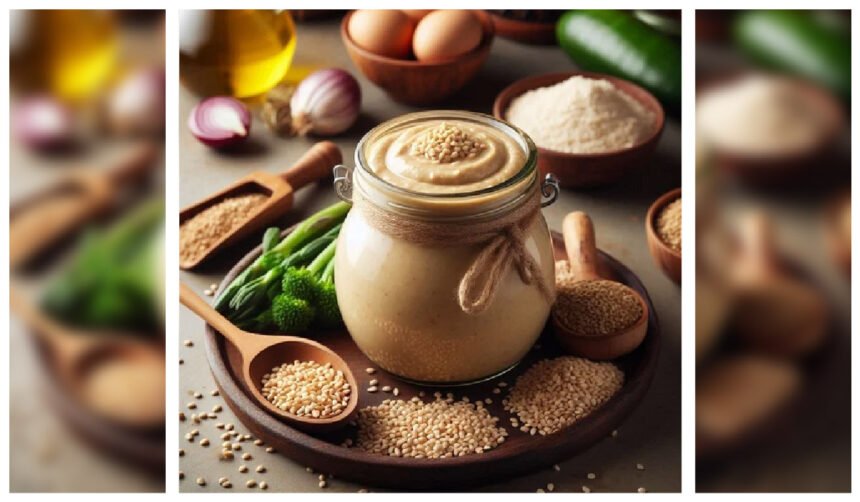What is Tahhiini?
Tahhiini is a creamy, rich paste made from ground sesame seeds that has captivated food lovers across the globe. This nutrient-dense ingredient, often spelled as “tahini” or “tahina” in different regions, is known for its nutty flavor and smooth texture. The word “tahhiini” might be a variation in transliteration, but the product remains a staple in both traditional and modern kitchens. Originating in the ancient world and cherished for its versatility, tahhiini has become a beloved component in both savory and sweet recipes.
Its rise to global popularity can be attributed to its adaptability in a range of cuisines and its impressive health benefits. In this comprehensive guide, we’ll explore everything you need to know about tahhiini—from its historical roots to creative culinary uses, health benefits, and even how to make your own batch at home.
Tahhiini Meaning and Definition
Tahhiini is a dense, velvety paste produced by grinding sesame seeds into a spreadable form. It can be made from hulled or unhulled sesame seeds, each yielding a different flavor profile. Hulled sesame seeds produce a lighter, smoother tahhiini, while unhulled seeds create a darker, more bitter paste with higher fiber content. Though the term “tahhiini” may vary in spelling across cultures, it is essentially the same product known commonly as “tahini” in English-speaking countries.
It’s the base for many iconic dishes like hummus and baba ghanoush, and it’s also celebrated for its ability to blend seamlessly into sauces, desserts, and health-centric diets. What sets tahhiini apart is its rich, nutty aroma and the slight bitterness that adds complexity to both sweet and savory meals.
The Origins and History of Tahhiini
The history of tahhiini stretches back thousands of years, tracing its roots to the cradle of civilization—Mesopotamia, ancient Egypt, and the Indus Valley. Archaeological evidence suggests that sesame seeds were one of the first crops cultivated for their oil content around 3000 BCE. In ancient Persia and Babylon, sesame was considered a symbol of immortality and often used in rituals and traditional medicine.
Tahhiini evolved as a byproduct of sesame oil extraction and quickly gained prominence as a shelf-stable, high-energy food ideal for travelers and warriors. In the Middle East and Mediterranean regions, tahhiini became a cultural symbol of hospitality and nourishment. As global trade expanded and culinary borders blurred, tahhiini found its way into Western kitchens, embraced by vegans, health-conscious consumers, and gourmet chefs alike.
How is Tahhiini Made? (Traditional and Modern Methods)
The process of making tahhiini can be both artisanal and industrial. Traditionally, sesame seeds are lightly toasted to enhance their flavor before being ground between stone wheels to produce a smooth paste. This method, still favored in some small-batch operations, retains the natural oils and nutrients of the seeds. Minimal ingredients are used—just sesame seeds and sometimes a pinch of salt or a bit of oil to adjust consistency.
In modern commercial production, high-powered food processors or industrial grinders are used to speed up the process. Seeds are roasted, then passed through grinding machines to achieve uniform texture. While modern tahhiini is more consistent, traditional methods are often preferred for their deeper flavor. Either method results in a nutrient-rich, versatile paste that can be used across a wide array of recipes.
Types and Varieties of Tahhiini
There are several types of tahhiini available, each offering unique taste and texture. Hulled tahini is made from sesame seeds with their outer shells removed, resulting in a creamier, lighter paste ideal for delicate sauces and desserts. Unhulled tahhiini, on the other hand, is darker and richer in fiber and nutrients, often favored for its earthy bitterness in robust dishes. Light tahini refers to lightly roasted seeds, which maintain a mild flavor, while dark tahini is made from more thoroughly roasted seeds, giving a deeper, toasted flavor.
You can also find organic, raw, or flavored varieties—infused with garlic, herbs, chocolate, or chili. Choosing the right type of tahini depends on your intended use: light versions for dressings and sweets, darker or unhulled for hearty meals and traditional dishes.
Nutritional Profile of Tahhiini
Tahhiini is a nutritional powerhouse packed with essential nutrients. It contains high levels of unsaturated fats, particularly omega-3 and omega-6 fatty acids, which support cardiovascular health. It’s also a plant-based source of protein, offering about 5 grams per two-tablespoon serving. Micronutrients in tahhiini include calcium, magnesium, phosphorus, iron, zinc, and vitamin B1 (thiamine), all vital for bone health, energy metabolism, and immune function.
The paste is also rich in antioxidants like sesamin and sesamolin, which help reduce inflammation and oxidative stress. Despite being calorie-dense—around 180–200 calories per two tablespoons—tahhiini provides high satiety and nutrition, making it an excellent addition to a balanced diet.
Health Benefits
The health benefits of tahhiini are extensive and well-documented. First, its high content of healthy fats helps lower bad cholesterol (LDL) and increase good cholesterol (HDL), contributing to better heart health. Second, tahhiini is a strong source of calcium and magnesium, crucial for bone strength and density, especially for those who are lactose-intolerant. Third, its protein and iron levels make it a great option for vegetarians and vegans looking to maintain energy and muscle health.
Tahhiini also contains lignans—plant compounds with antioxidant properties that support hormonal balance and may reduce cancer risk. Additionally, its natural oils and vitamin E content nourish skin and hair. Its fiber content promotes gut health and regular digestion. Being gluten-free, dairy-free, and nut-free, tahini suits many restrictive diets including keto, paleo, and plant-based.
Common Mistakes When Using Tahhiini
While tahhiini is easy to use, some common mistakes can hinder its flavor or texture. One frequent error is using tahhiini straight from the jar in recipes that require it to be thinned. Without liquid (like lemon juice or water), tahhiini can taste too dense or bitter. Another issue is incorrect storage—leaving it at room temperature for months can lead to rancidity.
It’s best stored in the fridge after opening. Over-roasting sesame seeds when making homemade tahhiini can also result in a burnt taste. People often misinterpret natural bitterness as spoilage, not realizing it’s due to using unhulled seeds. Lastly, many forget to stir tahhiini when the oil separates, missing out on the full creamy consistency it can offer.
Creative Culinary Uses
Tahhiini can be used in countless ways beyond hummus. As a base for dressings and sauces, tahini creates a luscious, tangy addition when mixed with lemon juice, garlic, and olive oil. You can swirl it into oatmeal or smoothies for a protein and flavor boost. It works beautifully on toast or sandwiches, especially with toppings like honey, bananas, or figs. Tahini is also ideal for topping roasted vegetables, grain bowls, or grilled meats.
In soups and stews, it acts as a non-dairy thickener, adding body and richness. For noodle dishes, a tahini-based sauce (often paired with soy sauce or chili oil) is a great substitute for peanut sauce, offering depth and complexity with a nut-free twist.
Baking and Dessert Recipes Using This
Tahhiini has found its place in the world of sweets. Tahhiini brownies are a popular vegan dessert, where its creamy texture keeps the batter moist while adding nutty undertones. In cookies, tahhiini can replace part of the butter or peanut butter to create a unique flavor and chewy texture.
Traditional Middle Eastern halva is made by combining tahini with sugar or honey and sometimes nuts for a firm, sliceable treat. You can also make frostings, protein balls, or even drizzle tahhiini over pancakes or waffles for a luxurious topping. It pairs especially well with ingredients like chocolate, cinnamon, dates, and maple syrup, giving bakers a healthy and flavorful edge.
How to Make Tahini at Home (Step-by-Step)
Making tahhiini at home is simple and rewarding. Start by toasting 2 cups of sesame seeds over medium heat until golden and aromatic—stir continuously to prevent burning. Let the seeds cool slightly, then transfer to a food processor or high-powered blender.
Pulse until crumbly, then add 2–4 tablespoons of oil (sesame oil, grapeseed oil, or sunflower oil) while blending. Continue until smooth and creamy. If the mixture is too thick, add more oil gradually. Optional: add a pinch of salt for flavor. Once done, store in an airtight jar. Homemade tahini can last up to one month in the refrigerator. For smoother results, slightly warm the oil before blending and avoid over-roasting the seeds.
How to Store Tahhiini Properly
Proper storage ensures tahhiini retains its flavor and nutritional quality. Unopened jars can be stored in a cool, dry pantry. Once opened, it’s best to refrigerate tahini to extend shelf life and prevent the natural oils from turning rancid.
Stir well before each use to recombine separated oils. If the tahini becomes too firm in the fridge, let it sit at room temperature or warm it slightly for easier handling. Avoid contaminating the jar with wet or dirty utensils, which can introduce mold or bacteria. Homemade tahhiini should always be refrigerated and consumed within 3–4 weeks.
Where to Buy Tahini
Tahhiini is widely available in supermarkets, usually found in the international or nut butter aisles. Middle Eastern and Mediterranean grocery stores often carry artisanal or region-specific brands with more authentic flavor profiles. Health food stores and co-ops also stock tahini, sometimes offering organic or raw versions.
Online platforms like Amazon, Thrive Market, and specialty food sites feature a wide range of options, including flavored and small-batch varieties. At farmers’ markets, you may find locally produced tahhiini made with unique roasting techniques and fresh sesame seeds. Always check labels for additives—high-quality tahini should contain only sesame seeds (and possibly salt).
Alternative Uses of Tahhiini (Beyond the Kitchen)
Tahhiini’s rich oil content makes it suitable for more than just eating. In skincare, tahhiini can be used as a hydrating face mask or moisturizer due to its vitamin E and antioxidant properties. Mixed with honey or yogurt, it becomes a soothing treatment for dry skin.
It can also be applied to hair as a conditioning treatment, especially for split ends and scalp hydration. As a natural exfoliant base, it can be combined with sugar or oats. Nutritionally, it can serve as a base for homemade energy bars. In some traditions, tahini holds ceremonial or ritual value, symbolizing nourishment and healing.
Tahini in Different World Cuisines
Tahhiini’s adaptability has made it a staple in many regional cuisines. In the Middle East, it is a key ingredient in hummus, baba ghanoush, and as a drizzle over falafel. In Mediterranean cooking, it enhances seafood, grilled vegetables, and lentil dishes.
In North African cuisine, tahhiini is used in spicy stews and couscous-based meals. Asian fusion chefs use tahini in noodle bowls, dumpling sauces, and stir-fries, replacing peanut or soy-based dressings. In Western health-conscious cooking, it’s popular in vegan cheese spreads, Buddha bowls, and baked goods. Each culture adapts tahini to its flavor traditions, proving its global culinary appeal.
Starting a Tahhiini Brand or Small Business
Launching a tahhiini brand can be both rewarding and profitable. Begin by sourcing high-quality sesame seeds, preferably organic and ethically grown. Invest in small-batch production methods to preserve freshness and flavor. Experiment with flavor variations such as chocolate tah hiini, chili-infused, or herb-blended versions. Your branding should emphasize health benefits, sustainability, and clean ingredients.
Packaging matters—use airtight glass jars with clear labels indicating ingredients and shelf life. Consider targeting vegan, paleo, and clean-eating communities with strategic marketing. Partner with local food co-ops, health stores, and online marketplaces to expand reach. Education-based marketing—like recipe blogs or sampling events—can help build customer trust and brand loyalty.
Conclusion
Tahhiini is more than just a condiment; it is a culinary treasure steeped in history and nutrition. From ancient Mesopotamian roots to modern-day health food movements, tahhiini continues to prove its value in kitchens around the world. Whether you’re seeking heart-healthy fats, plant-based protein, or just a rich, satisfying flavor enhancer, tahhiini delivers on all fronts.
Its creamy texture and nutty undertones make it a versatile addition to sauces, baked goods, and even non-food applications. By incorporating tahhiini into your pantry, you’re not just adding a spread—you’re embracing a timeless ingredient that bridges tradition, wellness, and creativity in every spoonful.
FAQs
1. What is tahhiini made from?
Tahhiini is made from ground sesame seeds. The seeds are usually roasted and then blended into a smooth, creamy paste. Sometimes a little oil is added to help achieve the right texture.
2. Is tahhiini healthy to eat?
Yes, tahhiini is very healthy. It contains good fats, protein, fiber, and important minerals like calcium, iron, and magnesium. It supports heart health, strong bones, and energy levels.
3. How do you use tahhiini in cooking?
Tahhiini can be used in dips, dressings, sauces, desserts, and even baking. You can drizzle it over salads, mix it into hummus, bake it into cookies, or blend it into smoothies.
4. Can you make tahhiini at home?
Yes, you can make tahhiini at home. Just toast sesame seeds, let them cool, and blend them with a little oil until smooth. Store it in a jar in the fridge for up to one month.
5. What does tahhiini taste like?
Tahhiini has a nutty, slightly bitter, and creamy flavor. The taste depends on how the sesame seeds are prepared—hulled seeds give a milder flavor, while unhulled seeds taste more earthy.
You May Read Also: A&TA Framework: The Smart Way to Fix Performance Gaps and Boost Growth
For More Information, Visit Dotmagazine









